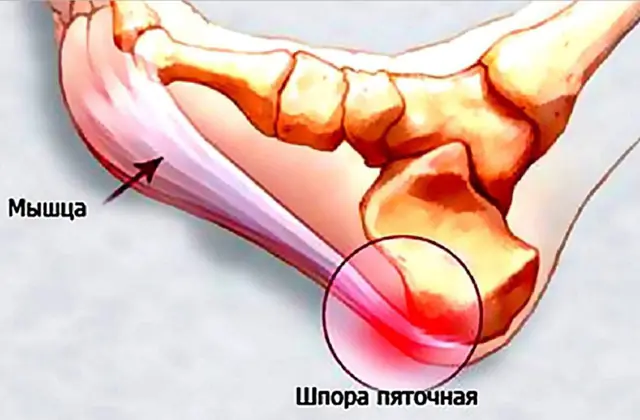
Causes of plantar fasciitis, symptoms of inflammation of the connective tissue in the sole. Diagnostic methods, treatment, prevention.
The content of the article:- Causes of plantar fasciitis
- Main symptoms
- Diagnostic methods
- Treatment options
- Medicines
- Physiotherapeutic procedures
- Physiotherapy
- Surgical intervention
- Folk remedies
- Prevention
Plantar fasciitis is an inflammation of the plantar connective tissue in humans. The disease is characterized by acute pain in the heel, which intensifies with load on the foot. It is colloquially called a heel spur because of the growth that often forms in the later stages of the disease.
Causes of plantar fasciitis
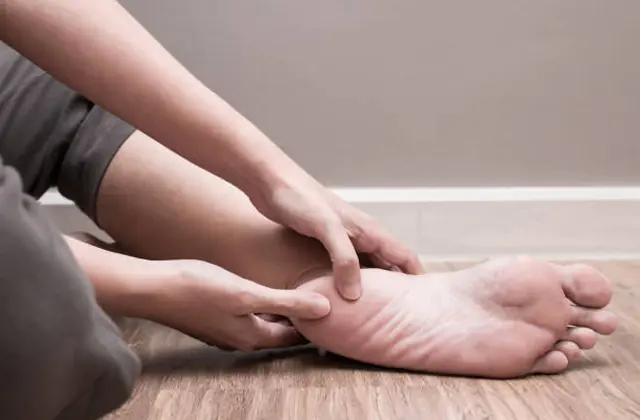
The plantar fascia connects the heel bone to the toes. She experiences a lot of stress every day, as she supports the longitudinal arch of the foot with pressure on it of 50% of the person’s weight.
Because of this, the connective tissue is subject to small stretches and micro-tears, which heal on their own during a night's rest. But severe injuries, excessive stress, and metabolic diseases lead to the development of plantar fasciitis.
Causes of the disease:
- genetic predisposition;
- professional dancing, sports;
- hard physical labor;
- frequent wearing of high-heeled shoes;
- playing sports in shoes without a shock-absorbing effect;
- excess weight;
- flat feet or excessively high arches of the foot;
- age-related degenerative changes in the body.
Plantar fasciitis of the foot is a complication of the following diseases:
- Osteochondrosis of the lumbar spine. Impaired functioning of the intervertebral discs in this part of the back leads to changes in gait and increased load on the foot.
- Obliterating atherosclerosis. Cholesterol deposition leads to thickening and partial blocking of the lumen of arterial vessels. In later stages, the disease manifests itself as necrosis on the heels and toes.
- Arthrosis. Destruction of the articular cartilages of the lower extremities leads to improper distribution of the load on the foot. The disease is a common cause of plantar fasciitis.
- Gout. The disease is characterized by the deposition of uric acid crystals in the joint tissues. In most cases, the big toes are affected, which changes the gait and leads to the appearance of inflammatory processes in the foot.
- Diabetes. A common complication of this disease is the appearance of ulcers on the foot. When infectious pathogens enter it, inflammatory processes occur that affect all tissues of the foot, including the plantar fascia.
Thus, plantar fasciitis does not develop rapidly and suddenly. It appears after a long course of other diseases or exposure to adverse factors.
Main symptoms of plantar fasciitis
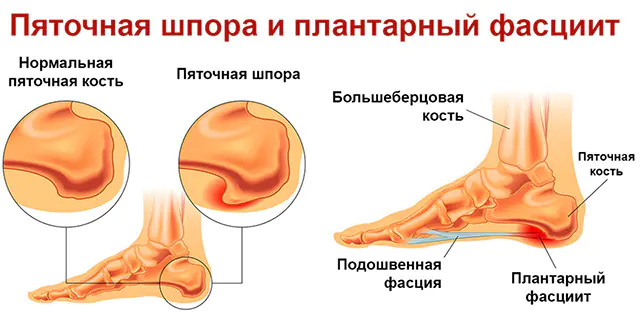
The main symptom of plantar fasciitis is severe pain in the heel area. It appears when getting to your feet after sleep, intensifies with movement, and becomes unbearable in the evening. Patients compare it to a needle prick and talk about the inability to move without additional support.
Externally, plantar fasciitis is manifested by swelling of the foot, redness and hyperthermia of the skin. A person’s gait changes, lameness appears, and then a deformity of the foot. The disease worsens a person's general well-being. Due to forced immobility, he gains excess weight and looks pale and weak.
Without treatment, plantar fasciitis leads to the development of dangerous complications:
- Achilles tendonitis. The sick person spares the heel and transfers the body weight to the front of the foot. Because of this, overstrain of the tendons of the soleus and gastrocnemius muscles appears. The disease is manifested by pain in the ankle, redness and hyperthermia in the area of inflammation.
- Heel spur. Plantar fasciitis alters the metabolism of the heel bone. As a result, a growth forms on it, which damages the soft tissue. This is what causes acute pain when standing on your feet.
- Rachiocampsis. Plantar fasciitis of the heel causes changes in gait. As a result, during movement, the patient cannot completely straighten his back and takes a forced body position. As a result, irreversible changes appear in the structure of the spine.
Vivid painful signs of the plantar fascia allow you to notice the disease at an early stage. Doctors recommend not to waste time and consult a doctor immediately after heel pain appears. The sooner treatment begins, the more gentle methods of therapy will be used to eliminate the disease.
Methods for diagnosing plantar fasciitis
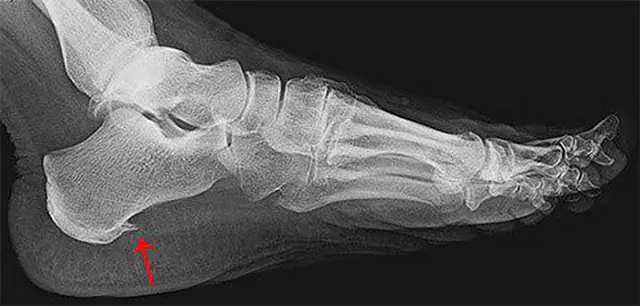
To identify the disease, you need to contact an orthopedist or traumatologist. The doctor examines the patient’s medical history and asks about the specifics of his professional activity. Next, he palpates the heel, identifying the pain point.
To confirm the diagnosis, the specialist refers the person to one of these procedures:
- Radiography. This method of diagnosing plantar fasciitis is considered the fastest and most accessible. The patient removes clothes and shoes from the sore leg and places it on the couch on top of a special film. The doctor turns on the machine and takes a picture. You can even see small (2-3 mm) bone growths on it.
- CT scan. A CT scan also scans the leg with X-rays. But as a result of this study, a series of layer-by-layer images appears, allowing you to see inflammation and growth from different angles. To do this, the patient sits on a couch, which slides inside the apparatus, which removes the legs from all sides.
- Ultrasonography. Ultrasound is considered the safest diagnostic method. Therefore, it is prescribed even to pregnant and lactating women. The patient sits on the couch, his foot is lubricated with gel, and the device’s nozzle is passed over it. At the same time, a black and white image of soft tissues and bone structures appears on the screen, on which you can see the inflammatory process and heel spur.
After studying the test results, the doctor makes a final diagnosis, tells the patient how to treat plantar fasciitis, and how to avoid the development of complications.
Treatment options for plantar fasciitis
The method of treating the disease depends on its stage. At the initial stages, the doctor prescribes conservative therapy. It includes taking medications, massage sessions, physiotherapy, and physical therapy. If a person continues to experience heel pain after treatment for plantar fasciitis, surgery is performed to excise the connective tissue or remove the heel spur.
Medications to treat plantar fasciitis

To relieve the inflammatory process of the plantar fascia, the following medications are prescribed:
- Ibuprofen. The medicine belongs to non-steroidal anti-inflammatory drugs. It can extinguish the inflammatory process, reduce pain, and normalize body temperature. Price - from 62 rubles in Russia (26 hryvnia in Ukraine) for 50 tablets.
- Diclofenac. This analogue of Ibuprofen also has a pronounced anti-inflammatory effect. It is available in the form of a liquid for injection, so it penetrates the blood faster and improves a person’s well-being. Price - from 90 rubles in Russia (40 hryvnia in Ukraine) for 10 ampoules.
- Hydrocortisone. Ointment for the treatment of plantar fasciitis allows you to relieve the inflammatory process with the help of synthetic glucocorticosteroids. The result appears after daily application of the medicine for 10-14 days. Price - from 90 rubles in Russia (40 hryvnia in Ukraine) for 10 g.
Drug treatment for plantar fasciitis is possible at home. But if you feel worse or new symptoms appear, you should consult a doctor to adjust the dosage of the medication.
Physiotherapeutic procedures for plantar fasciitis

Physiotherapy sessions improve blood circulation in the foot and enhance the effect of medications.
Particularly effective methods include:
- phonophoresis - exposure to ultrasonic waves;
- electrophoresis - exposure to electric current;
- laser therapy - exposure to beams of light;
- magnetotherapy - exposure to a magnetic field.
When purchasing shoes for plantar fasciitis, pay attention to the following points: for example, models for everyday wear should have a strong fit, rigid ankle boots, a stabilizing element in the sole, a small heel, and an orthopedic insole. Only professional sneakers with a shock-absorbing effect are suitable for sports.
Therapeutic exercises for plantar fasciitis
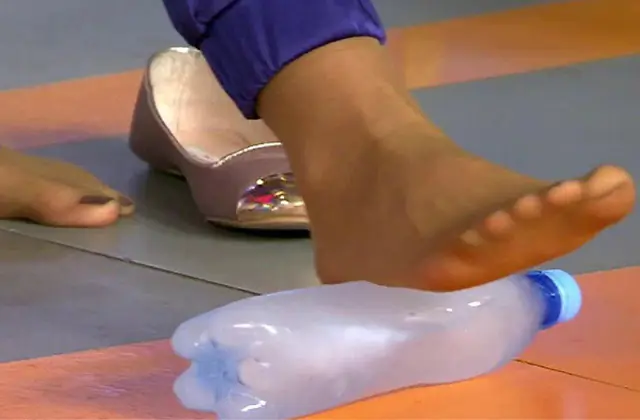
Gymnastics are performed in the early stages of plantar fasciitis. It helps develop foot muscles, stretch and relax connective tissue.
To do this, you need to perform the following exercises daily:
- Shift your body weight from foot to foot.
- Bend towards the floor without bending your knees.
- Stand on your toes for as long as possible.
- Pick up small objects with your toes.
- Roll a small ball with your foot.
- Apply pressure to the fascia area and massage it in a circular motion.
Exercises for the treatment of plantar fascia should be performed barefoot in comfortable clothing in a well-ventilated room.
Surgery for plantar fasciitis
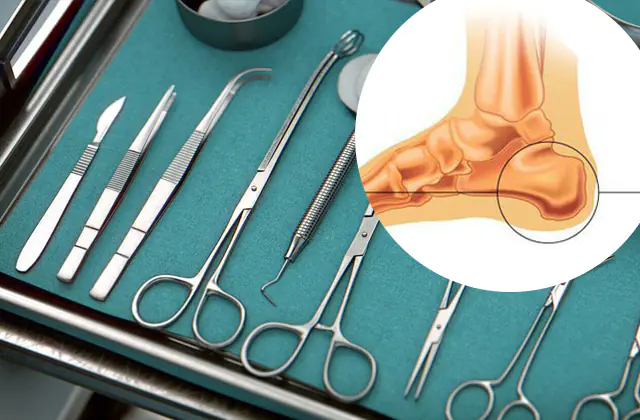
Surgery is prescribed if plantar fasciitis cannot be cured within one year. Indications include acute heel pain, persistent limitation of physical activity, and significant deterioration in quality of life.
The operation is performed under local anesthesia. The surgeon makes an incision in the area of the bottom of the sole. After examining the connective tissue, he will cut it slightly (to relieve tension), separate it from the heel bone, or remove a small section of damaged fascia.
Heel spur removal is performed under general anesthesia. The surgeon makes an incision in the area of the growth, files it down, and removes the fragments. At the last stage, he stitches the tissue layer by layer and covers the seam with a sterile bandage.
Folk remedies against plantar fasciitis

To treat plantar fasciitis, you can use folk remedies. A good result is achieved after applying therapeutic compresses at night. So, grate black radish and horseradish on a fine grater, mix in a 4:1 ratio. Attach the mixture to the sole using cling film. Wear warm socks. In the morning, wash your feet with warm water.
Another effective method of traditional medicine is foot baths. To prepare them, dilute 10 tablespoons of sea salt in 3 liters of warm water, dip your feet in it, and warm for 30 minutes. Afterwards, dry your feet, put on cotton socks, and cover yourself with a blanket.
In addition to sea salt, you can use the following for foot baths:
- soda and iodine (10 drops per 1 tablespoon);
- turpentine and table vinegar (in a ratio of 1:1);
- infusion of green walnut peel;
- crushed tablets of Furacilin and Analgin (2 tablets per 1 liter of water).
Prevention of plantar fasciitis
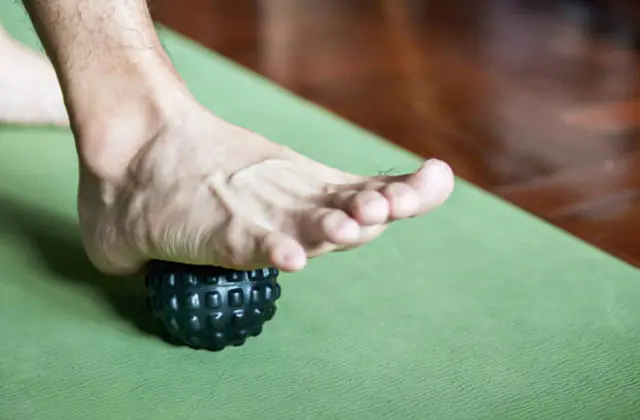
Change your profession if you experience heel pain at the end of the workday. When playing sports, do not exceed the load recommended by the instructor. Follow the technique of performing exercises on the simulators.
Watch your weight and prevent the development of obesity. To do this, adhere to the principles of a healthy diet, give up fatty, heavy foods. Make nutritious, easily digestible foods the basis of your daily diet.
Do not wear tight shoes, high-heeled shoes, or flat-soled ballet shoes for everyday wear. When jogging or playing sports, wear only sports shoes that are made of breathable material and have a shock-absorbing effect.
Don't ignore the symptoms of flat feet. Buy insoles to correct your feet and put them in your shoes for everyday wear. Perform therapeutic exercises, perform acupuncture and massage procedures.
Don't skip medical examinations. Plantar fasciitis at an early stage is easily diagnosed and treated with gentle methods. Follow all doctor's instructions. Do not skip taking medications, physiotherapy sessions, or therapeutic exercises.
Video about plantar fasciitis, what it is and how to cure it:



